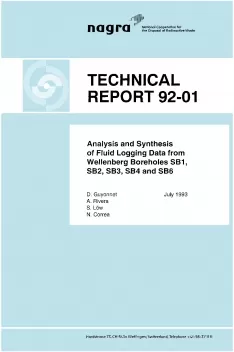
Technical Report NTB 92-01
Analysis and Synthesis of Fluid Logging Data from Wellenberg Boreholes SB1, SB2, SB3, SB4 and SB6
This document presents the results of the detailed quantitative analysis and synthesis of fluid logging data measured in the Wellenberg boreholes SB1, SB2, SB3, SB4 and SB6 as part of Nagra's characterization program for the Valanginian Marl which is considered as a potential host rock for low- and intermediate-level radioactive waste.
The fluid logging method involves measuring the electrical conductivity and temperature along a pumped borehole after it has been flushed with a fluid with an electrical conductivity and temperature which contrast with those of the formation fluid. Inflow of formation fluid results in electrical conductivity peaks. Quantitative analysis of these peaks provides estimates of hydraulically active feature (HAF) transmissivities, inflowing fluid concentrations and some indications on HAF formation head.
A review of the main assumptions underlying the various codes for quantitative interpretation of the measured logs provides a basis for selecting the appropriate methodology. Examination of the temporal variability and uncertainty related to parameters critical for the analysis (in particular drawdown and inflowing fluid concentration) shows that for all tests there are several logs which are suitable for analysis with BORE, a finite difference code which simulates one-dimensional advective-dispersive transport with multiple inflows.
Unlike previous fluid logging analyses where BORE simulations were performed manually by iteratively adjusting inflow rates and inflowing fluid concentrations to minimize the difference between measured and simulated logs, the approach selected here is to minimize the differences automatically using STARBORE, an inverse model which uses BORE at each iteration. One of the important advantages of this approach compared to previous analyses is that, in addition to estimates of inflow parameters which result in an optimal match between measured and simulated logs, estimates of the uncertainty (standard deviations) affecting each modelled parameter are obtained. STARBORE successfully converged to a minimum of the objective function (sum of square residuals) for all fluid logging tests except one due to insufficient peak development.
HAF flow rates estimated by STARBORE were used to determine HAF transmissivities, taking into account the uncertainty affecting the parameters involved in the calculation (in particular inflow zone formation heads and inflow zone storativities).
